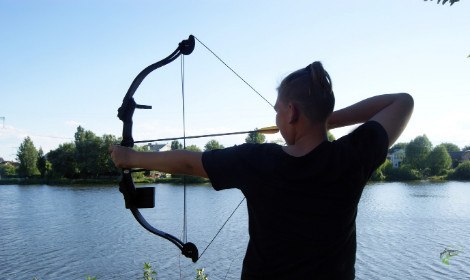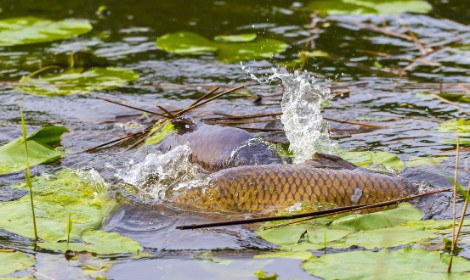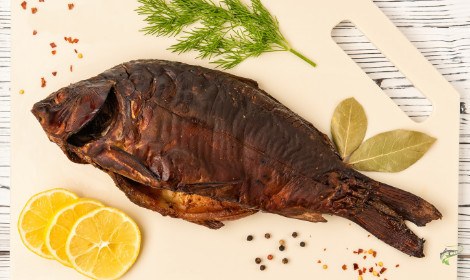
In the UK and Europe carp are prized as a sort of sport fish with many anglers targeting these large fish with the best interest of keeping them fit and healthy for other people to catch.
However, accross the US and Canada carp are fast becoming a massive problem as an invasive species where drastic measuers are taken to reduce their population rapidly.
Bowfishing for carp has become incredibly popular in the United States and Canada in the last decade. It’s a cross between hunting and fishing and helps to keep invasive carp populations in check on some waters, and is also great as a recreational pastime.
In this you will find exactly how to bow fish for carp from the perspective of a bow fisherman in the U.S.
Gear
Bow fishing requires some special gear to get started. Let’s take a look at the gear needed and what options you have in regards to the gear itself.
Bow
To the surprise of no one reading this, you need a bow! You don’t need a top-of-the-line hunting bow to bow fish though; these new bows can run over $1000 dollars and, in many cases, aren’t really the best tool for the job.
If you are just getting started in bow fishing, an old bow from the pawnshop or one you have sitting in your basement will work just fine. Just make sure the strings are in good condition.
Recurve bows are the best-suited bow for bow fishing, in my opinion. It allows for easy snapshots, allowing you to pull quick shots on moving fish without having to come to a full draw like a compound. Overall recurve bows are the most versatile bow for bow fishing.
The draw weight of the bow does not need to be nearly as high as for bowhunting large game, and high draw weights are actually detrimental to your carp slaying cause.
Good draw weights for bow fishing are around 45 to 55 pounds; this allows you to use less effort and get to full draw faster and easier, and still have the power to transfer to the arrow to penetrate into the water column.
Arrows
Arrows for bow fishing are very different from the arrows used to target practice and hunt animals.
Bow fishing arrows are long and thick when compared to carbon or graphite arrows commonly used for hunting and target shooting today.
They are made of fiberglass, which gives them a decent amount of weight; this weight is needed to transfer energy to the arrow and help it penetrate the water, something that the ultralight carbon arrows wouldn’t be able to do and would lose energy very quickly.
The tip of a bow fishing arrow is threaded and can screw off or on, and behind the tip are the barbs. The barbs are around 1.5 to 2 inches long and keep the arrow from pulling out of a fighting carp.
The arrow tips when taken off allow the barbs to flip in the opposite direction, aiding in pulling the arrow through and out of a fully penetrated fish.
Reels and spools
The last and one of the most important pieces of bow fishing gear is the reel or spool.
Spools are the cheaper alternative and “old school” retrieval system. It’s simply a spool about 6-8 inches in diameter with a clip to keep the arrow line from unspooling. The force of the shot pulls the string from the clip, allowing the line to unravel.
Spools are more time-consuming, as you have to manually wrap the line on the spool after every shot. This means missed shot opportunities as fish swim by while retrieving your line.
Spools are also dangerous. If you do not wrap the line properly, for instance, when you’re in a hurry, it can stretch mid-shot and send the arrow flying back in your direction like a high-speed rubberband. I have had this happen a few times, and it’s a heart-stopping experience. In the best-case scenario, your 100+ lb line cracks and snaps like a whip, and you watch your arrow sail across the river or sink to the depths.
Reels like the AMS Retriever are, in my opinion, the best option for arrow retrieval on the market, and I would highly recommend beginners to go this route.
The reel attaches to your sight mount and has a container that holds the line. The line is stacked vs. wound, meaning no tangles.
The reels have a trigger that, when depressed with your trigger finger, allows you to crank the line in similar to a fishing reel and a line clip to prevent the line from free spooling out of the container.
Where to Bowfish

Carp like weedy and shallow areas, particularly in the spring. Areas with brush, stumps, reeds, and trees are also great areas to stalk either by boat or on land.
Don’t discount shallow rocky rivers in the spring, and wading in this shallow water with waders with carp swimming around you by the dozens or even hundreds during spawning in the spring can be some of the most action-packed bow fishing out there, just be sure to bring extra tips and even arrows, as the rocks will do a number to your tips.
Carp in most places can be found in vast numbers all over the U.S., so chances are any nearby streams, rivers, lakes, canals, and ponds will have carp. Heck, growing up, we even shot carp in flooded farm fields wearing waders that were adjacent to creeks in the spring.
Shooting Tips and Tricks
Even though much of the shooting you will do while bow fishing is at a fairly short range to point-blank range, it is by no means easy.
Sights like you would use for target shooting or hunting are not much help on a bow set up for bow fishing. This is due mainly to shooting at moving targets at varying distances, and most importantly, due to water refraction.
If your not familiar with what water refraction is or simply need a refresher, take a clear glass and fill it half full with water, now stick a pen or pencil in it. You will notice it looks like the pencil is broken or offset at the waterline.
So what does water refraction mean for bow fishermen? Water refraction is so significant to us because when we observe a fish below the surface of the water, it’s actually in a different location than where it appears.
This illusion means we have to adjust our aim and aim lower as if we were going to shoot underneath the fish.
But the distances that we aim under a fish depends on more than just refraction itself, as the distance from us to the target and depth also play a role at the angle we have to adjust in compensating for water refraction. This is where the challenge or bow fishing really shows.
Over experience and hundreds of shots, you will develop an instinctive aim, without having to think about it much, you will know if the fish is deeper and farther away from you that you will have to aim considerably lower than the target, or in other cases just below the belly of the carp for shallower and closer shots.
What do Bowfishermen Do with the Carp?

There are various things that happen to shot carp, and in many cases, a bow fisherman can finish a day or night on the water with hundreds of pounds of harvested carp.
Some bow fishermen smoke the carp for consumption in a smoker, but due to possibly having so many fish, many only keep a few if they plan on eating them.
Carp is not preferred table fare for most people, myself included. It’s just one of those fish that Americans don’t consider being good to eat when compared to other fish like perch and walleye, particularly in the Midwest regions.
But there are other ways to put carp to good use, such as using the, in gardens for fertilizer or compost piles. Many farmers will also allow you to put the carp in their fields for fertilizer.
In my personal case, a local about a mile from my house asked if I would take my carp to his pig farm and feed them to the pigs.
Culture Shock
To many anglers in the U.K. or Europe reading this article, there might be a bit of culture shock to the killing of carp in the form of bow fishing in the United States, and this is something I totally understand, but one has to remember that carp in North America are a serious threat to native ecosystems.
For example, on the small 100-acre lake where I live and do much of my bow fishing, there is a bounty that has been placed on carp by the “property owners association,” which is something common in Wisconsin. People who own property on the lake form a club, so to speak, where they raise money from membership fees and donations to fund projects that can vary from invasive species prevention and management to improving fish habitat by building fish cribs or improving shorelines.
The bounty for carp on my particular lake was 2 dollars a fish growing up, and I would pay my cellphone bill as a teenager solely by the proceeds I made from shooting carp, which easily could be a dozen fish in a single day, even on a small lake such as the one I grew up on, hundreds of fish a year being harvest by myself would not even dent the incredibly dense population in the lake, and gave me a front-row seat to the invasive species issue.
If you want to know more about carp as an invasive species, we have an entire article on the blog dedicated to the subject.
Conclusion
Bow fishing carp, while probably seeming barbaric to many across the pond in Europe, has to be viewed in a situational manner to North America.
Even with its rise in popularity over the last decade, it’s still not capable of massively reducing the number of invasive carp overall, but it certainly doesn’t hurt.
If you are interested in trying bow fishing, the gear is the most important part, and this article will help guide you in what you will need to get started.

